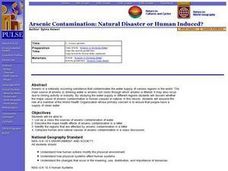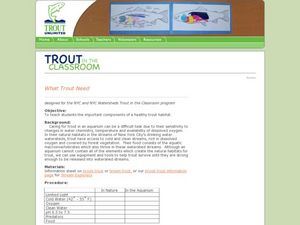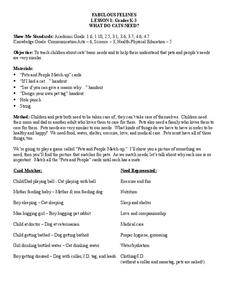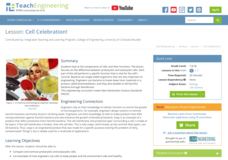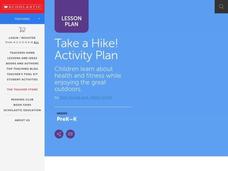Curated OER
Family Vacation at the Beach
While a simple story, this reading comprehension and vocabulary activity could be used with younger learners to cement important skills. By answering the 10 questions in this activity, students could practice reading a passage and...
Curated OER
4-H Horticulture/Garden Activity Page- Beginning
In this 4-H garden project worksheet set, student study the parts of seeds and plants. They make a mini-greenhouse. They complete a career scavenger hunt, tools word search, and experiment to learn more about the effect of water on seed...
Curated OER
HANUKKAH: A Mini-Unit
Students engage in a variety of activities concerning the holiday of Hanukkah. The use of brainstorming important to generate ideas and tap prior knowledge. They move from brainstorming to a choice of other activities.
Curated OER
Clean Air: Our Health Matters
Students learn about the human respiratory system. In this pollution instructional activity, students identify the parts of the respiratory system and what happens to them when they breathe in polluted air. Students learn about the...
Curated OER
Strawberry DNA extraction
Students study the basic function of DNA and then extract it from strawberries. In this DNA extraction lesson students examine DNA and see why the extraction of it is so important to scientists.
Curated OER
Spark Activity: Snakes and Lizards
Students are divided into 2 groups: "snakes" and "lizards." Lizards move about the room in a way designated by the teacher, while snakes remain on their "rock" holding a given object and perform a balancing movement. Lizards guess what...
Curated OER
Arsenic Contamination: Natural Disaster or Human Induced?
Learners list as a class the sources of arsenic contamination of water. They describe the major health effects of arsenic contamination in a letter. Students identify the regions that are affected by it.
Curated OER
Where Do You Fit In?
Students study habitats and then draw a picture of their own habitat which includes the location of food, water, and shelter, and the concept of space. then they cut their habitat in half and discuss how this would affect their lives.
Curated OER
What Trout Need
Students investigate the important components for a healthy trout habitat. In this fish habitat lesson, students discuss how the aquarium will simulate a trout's environment in nature. Students complete a trout information sheet to set...
Curated OER
Keeping Warm
Fifth graders measure the temperature of water using a thermometer. They record the temperatures of water on a chart. Students use the temperature data to determine which materials are the best conductors of heat. They discuss their...
Curated OER
Aquifers and Recharge Areas
Students create a model of an aquifer and describe how an aquifer works. They describe how running affects an aquifer and prepare a model presenting to local planners the important aspects of protecting recharge areas.
Curated OER
Milk: A Practical Application
Students examine the impact of the physical and chemical properties of milk and its use as an important food.
Curated OER
Nutrition and Health
Young scholars explore the conditions faced while sailing on the ocean regarding health and physical fitness. They experience the importance of Vitamin C. Students analyze the cause of many diseases and sicknesses on the ships.
Curated OER
Midnight Dumpers
Students explain how pollution affects ground water. They participate in a simulation to discover the location of an illegal dump. Students explore the monetary benefits, risk and environmental concerns are factors in business decisions.
Curated OER
Nutrition and Physical Education Activities in the Classroom
You can promote health and wellness using nutrition activities and lessons. With physical education activities and suggestions about snack times, you can help impvove the habits of the youngsters under your charge.
Curated OER
Fabulous Felines
Students explore basic needs through discovering that pets and people need very similar things. They will play matching games, sing songs, read books, and discuss the needs of people and animals.
Curated OER
Reading Comprehension 1
Bring this non-fiction text into your eleventh and twelfth grade classrooms. Your high schoolers will read the long passage provided, and use the information to complete eight multiple-choice questions. The answer sheet details where one...
Teach Engineering
Cell Celebration!
Are you eukaryotic? (Answer: Yes.) The first of six installments in the Cells units teaches pupils about the similarities and differences of prokaryotes and eukaryotes. It also covers the functions of various cell components in both...
Teaching Ideas
The Victorians Fact Cards
Want to learn some quick facts about Victorian England? Check out a series of fact cards that include information about class structure, education rights, public health, and Queen Victoria herself.
Curated OER
Hos Do the Jaguar and Howler Monkeys in Belize Depend on Us?
First graders access the internet and use the sites provided to research Belize, and in particular, the Howler Monkey and Jaguar. Students participate in activities/centers utilizing the information they discovered.
Teach Engineering
Biological Processes: Putting Microbes to Work
Is there such a thing as useful microbes? Get ready to perform experiments on applying microbes for wastewater treatment. The first installment of the three-part unit provides background information to prepare young engineers for two...
Curated OER
Take a Hike!
Students explore the benefits of staying active by going on a hike. In this physical education lesson, students discuss the concept of a hike, where a good place to hike is and what types of foods are necessary to stay nourished....
Curated OER
On a Hot Day, You Can Play Forever
In this science and thought process worksheet, students read a factual information sheet on many ways humans can keep cool on hot days. Students answer 30 questions.
Curated OER
Rivers Through Time
Students read or have the book A River Ran Wild read to them. They discuss and reflect on the messages presented in the book. Students use their listening comprehension skills to draw conclusions. Students articulate several examples of...








